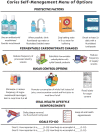Evidence-Based Caries Management for All Ages-Practical Guidelines
- PMID: 35048005
- PMCID: PMC8757692
- DOI: 10.3389/froh.2021.657518
Evidence-Based Caries Management for All Ages-Practical Guidelines
Abstract
Introduction: The purpose of the present paper is to provide step-by-step guidelines for dental healthcare providers to manage dental caries based upon caries risk assessment (CRA) for ages 0-6 years and 6 years through adult. The manuscript reviews and updates the CAMBRA (caries management by risk assessment) system which includes CRA and caries management recommendations that are guided by the assessed risk level. Caries Risk Assessment: CAMBRA CRA tools (CRAs) have been evaluated in several clinical outcomes studies and clinical trials. Updated CAMBRA CRAs for ages 0-6 years and 6 years through adult are provided. These CRAs have been refined by the addition of a quantitative method that will aid the health care provider in determining the caries risk of individuals. Caries Management Based Upon Risk Assessment: Guidelines for individualized patient care are provided based upon the caries risk status, results of clinical exams and responses of the patient to questions in the CRA. These guidelines are based upon successful outcomes documented in several clinical outcomes studies and clinical trials. The paper includes a review of successful caries management procedures for children and adults as previously published, with additional emphasis on correct use of silver diamine fluoride (SDF) for children. The caries management plan for each individual is based upon reducing the caries risk factors and enhancing the protective factors with the additional aid of behavior modification. Beneficially altering the caries balance is coupled with minimal intervention restorative dentistry, if appropriate. These methods are appropriate for the management of dental caries in all patients.
Keywords: caries management; caries risk assessment; dental caries; fluoride; infants and toddlers.
Copyright © 2003, 2007, 2010, 2011, 2019, 2020, 2021 The Regents of The University of California.
Conflict of interest statement
The authors declare that the research was conducted in the absence of any commercial or financial relationships that could be construed as a potential conflict of interest.
Figures
References
-
- Featherstone JDB, Crystal YO, Chaffee BW, Zhan L, Ramos-Gomez F. An updated CAMBRA caries risk assessment tool for ages 0 to 5 years. J Calif Dent Assoc. (2019) 47:37–47. Available online at: https://www.cda.org/Portals/0/journal/journal_012019.pdf
-
- Featherstone JDB, Alston P, Chaffee BW, Rechmann P. Caries management by risk assessment (CAMBRA®) - an update for use in clinical practice. J Calif Dent Assoc. (2019) 47:25–34. Available online at: https://www.cda.org/Portals/0/journal/journal_012019.pdf - PMC - PubMed
-
- Featherstone JD. The caries balance: contributing factors and early detection. J Calif Dent Assoc. (2003) 31:129–33. Available online at: https://www.cda.org/Portals/0/journal/journal_022003.pdf - PubMed


